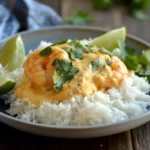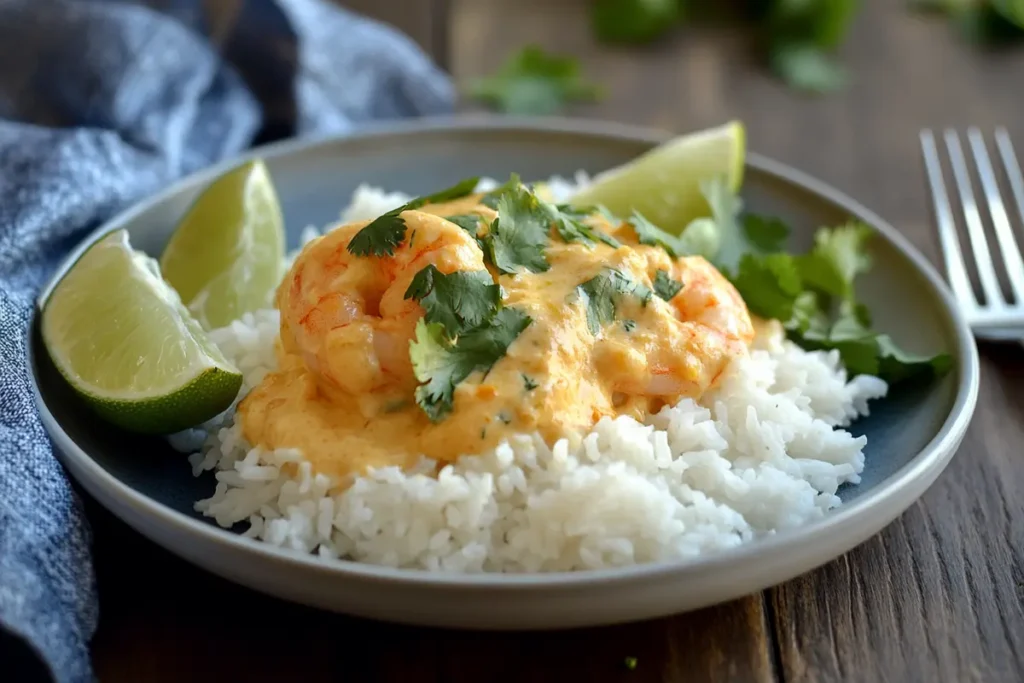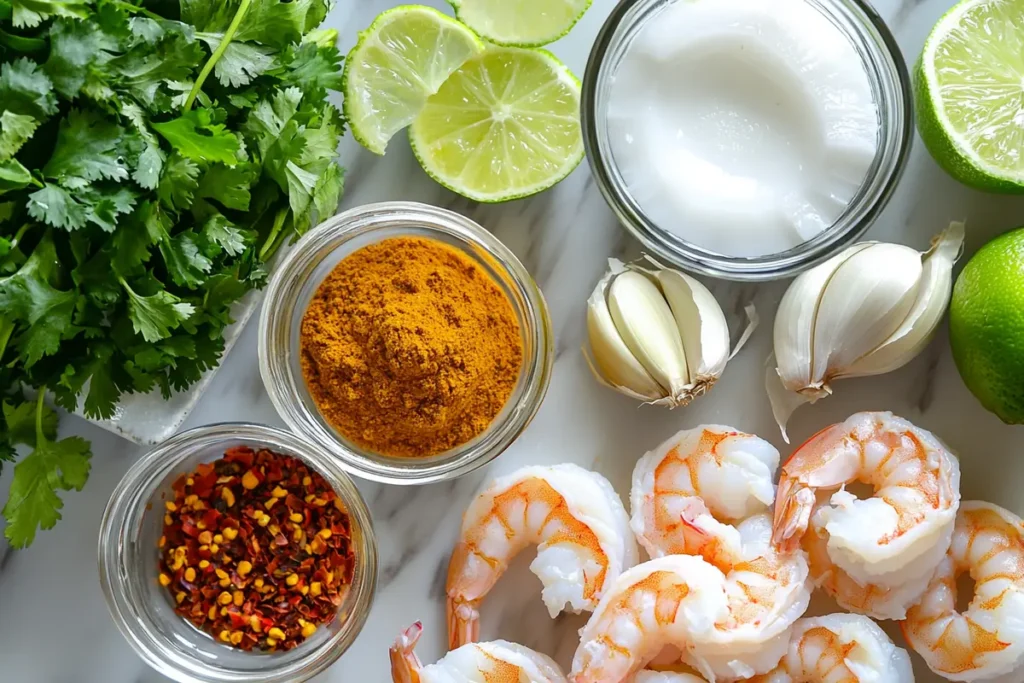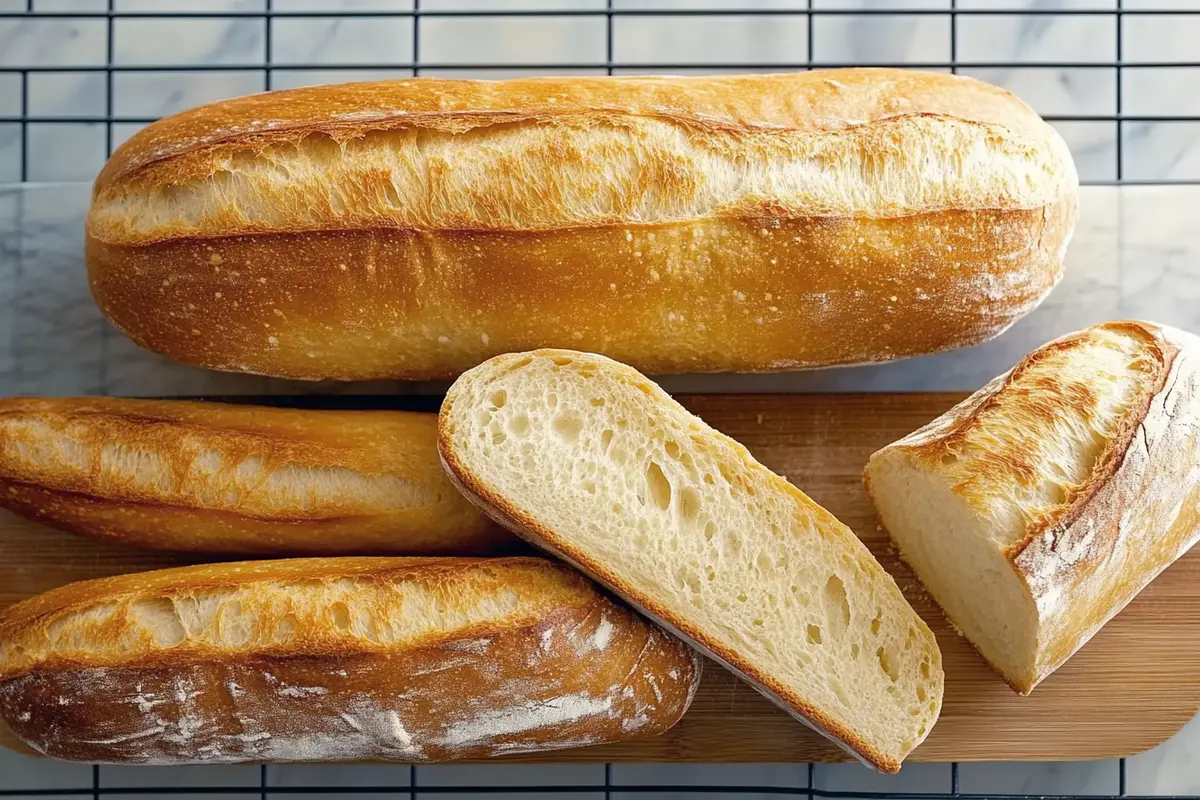Craving something creamy, savory, and bursting with tropical flavors? A creamy coconut shrimp recipe could be just what you need! This dish perfectly blends the sweetness of coconut milk with tender shrimp and aromatic spices, offering a meal that feels luxurious yet is surprisingly simple to prepare. Whether you’re cooking for a special occasion or just need a quick weeknight dinner, this recipe delivers flavor and satisfaction.
What is Creamy Coconut Shrimp?
Why Coconut Shrimp is a Culinary Favorite
Creamy coconut shrimp stands out because of its rich, indulgent flavor that feels both exotic and comforting. The velvety coconut sauce wraps around tender, juicy shrimp, creating a dish that’s decadent yet light. This recipe is cherished in tropical cuisines, from Southeast Asia to the Caribbean, each region adding its spin with local herbs and spices.
Flavor Profiles that Make it Irresistible
At its core, this dish is a fusion of sweet, savory, and spicy elements. The natural sweetness of coconut milk balances the slight brininess of shrimp, while spices like turmeric and red pepper flakes add warmth and complexity. The addition of fresh lime juice and cilantro provides a zesty freshness that ties it all together.
Cultural Significance Across Regions
In Thai cuisine, a variation of this dish often includes lemongrass and a hint of fish sauce, while Caribbean interpretations might add pineapple for a fruity twist. Regardless of its form, creamy coconut shrimp recipes highlight the versatility of coconut as a staple ingredient, offering something for every palate.
Ingredients and Preparation
Essential Ingredients for Creamy Coconut Shrimp
- Shrimp: Fresh, large shrimp are a must! They lend a plump, juicy texture that complements the creamy sauce. Deveining and cleaning them ensures the dish is both flavorful and visually appealing.
- Coconut Milk: Opt for full-fat coconut milk for a luxurious, silky base. It’s the star ingredient that brings a tropical essence to every bite.
- Aromatics: Garlic, ginger, and onions work together to build the foundation of the dish’s flavor, adding layers of warmth and earthiness.
- Spices: Turmeric brings a golden hue and subtle warmth, while red pepper flakes deliver a hint of spice that enhances the natural sweetness of the coconut milk.
- Citrus: Fresh lime juice cuts through the richness, adding brightness and balance.
Step-by-Step Preparation Guide
Preparing the Shrimp
Start by peeling and deveining the shrimp. Rinse them under cold water and pat dry with a paper towel. Removing excess moisture ensures the shrimp cook evenly and absorb the flavors of the sauce.
Sautéing the Aromatics
In a large skillet, heat 2 tablespoons of cooking oil over medium heat. Toss in minced garlic, grated ginger, and finely diced onions. Stir frequently until the mixture is fragrant and the onions turn translucent, about 2-3 minutes.
Adding Spices
Sprinkle turmeric and a pinch of red pepper flakes into the skillet. Stir well to combine, allowing the spices to bloom in the hot oil. This step intensifies their flavors, making the dish even more aromatic.
Introducing Coconut Milk
Gently pour the coconut milk into the skillet, stirring constantly to create a smooth, creamy sauce. Reduce the heat to low and let the mixture simmer for 5 minutes. This allows the flavors to meld and the sauce to thicken slightly.
Cooking the Shrimp
Add the cleaned shrimp to the skillet, ensuring they’re fully coated in the sauce. Cook for 3-5 minutes, flipping them halfway through, until they turn pink and opaque. Be careful not to overcook, as shrimp can become rubbery.
Finishing Touches
Turn off the heat and squeeze the juice of one lime over the dish. Garnish generously with chopped cilantro to add a pop of freshness and vibrant color. Serve immediately while the sauce is still warm and creamy.
Variations and Serving Suggestions
Regional Variations of Coconut Shrimp
The beauty of a creamy coconut shrimp recipe lies in its adaptability. Different regions put their unique spin on this dish, showcasing diverse culinary traditions.
Asian Influence
In Thailand, creamy coconut shrimp often incorporates lemongrass, lime leaves, and galangal, elevating the dish with bold, citrusy notes. It’s commonly served over fragrant jasmine rice, allowing the aromatic sauce to seep into every grain. A splash of fish sauce or tamarind paste might also be added, creating a delicate balance between sweet, sour, and salty flavors.
Caribbean Twist
The Caribbean version takes a playful, tropical approach by introducing fruits like pineapple or mango. These additions not only enhance the sweetness of the coconut milk but also add a refreshing juiciness to the dish. Locally beloved spices such as allspice and nutmeg may also make an appearance, giving it a distinctly warm and festive vibe.
Indian Inspiration
In Indian cuisine, creamy coconut shrimp often leans on robust spices like curry leaves, mustard seeds, and coriander. Paired with basmati rice or flatbreads like naan, this variation delivers a punch of flavor while maintaining the dish’s signature creamy texture.
Serving Suggestions and Pairings
Rice
Steamed jasmine or basmati rice is a classic pairing. Its subtle aroma and fluffy texture are perfect for soaking up the luscious coconut sauce. For a healthier twist, consider brown rice or quinoa, which add a nutty flavor and extra nutrients.
Noodles
Rice noodles or even linguine can transform this dish into a coconut shrimp pasta. The silky sauce clings beautifully to the noodles, making every bite flavorful and satisfying.
Vegetables
Balance the richness of the dish with a side of sautéed greens like spinach or bok choy. Alternatively, a crisp cucumber and carrot salad dressed with lime vinaigrette offers a refreshing contrast to the creamy shrimp.
Tropical Sides
Why not embrace the tropical theme? Pair the dish with fried plantains, a side of roasted sweet potatoes, or even a chilled mango salsa. These sides amplify the exotic flavors while adding a fun and colorful element to your plate.
Nutritional Information and Health Benefits
Nutritional Profile of Creamy Coconut Shrimp
- Protein Powerhouse: Shrimp is a lean source of protein, essential for muscle repair and overall body function. A serving of this dish provides a satisfying amount of high-quality protein without excessive calories.
- Healthy Fats: Coconut milk is rich in medium-chain triglycerides (MCTs), which are easier to digest than other fats and can serve as a quick energy source. Unlike unhealthy saturated fats, MCTs are associated with positive health effects.
- Vitamins and Minerals: This dish offers a range of micronutrients, including selenium, which supports immune function and thyroid health, and vitamin D, essential for bone strength. Shrimp is also a source of iron, which helps maintain healthy red blood cells and prevent fatigue.
Health Benefits of Key Ingredients
Shrimp
Shrimp is a nutrient-packed powerhouse. It’s low in calories but high in protein, making it ideal for those looking to maintain a lean diet. Additionally, it’s loaded with iodine, a mineral essential for thyroid function, and omega-3 fatty acids, which promote heart and brain health. These nutrients can also help reduce inflammation, contributing to overall wellness.
Coconut Milk
Coconut milk not only adds a creamy texture but also delivers unique health benefits. Its MCTs may support weight management by promoting fat burning and boosting metabolism. Furthermore, it contains lauric acid, which has antimicrobial properties and may strengthen the immune system. Rich in antioxidants, coconut milk helps protect the body from free radical damage.
Aromatics and Spices
Ingredients like garlic, ginger, and turmeric bring more than just flavor. Garlic and ginger are known for their anti-inflammatory and immune-boosting properties. Turmeric, with its active compound curcumin, may reduce inflammation and improve brain function.
Here’s the approximate nutritional breakdown for the dish, per 100g serving:
| Nutrient | Amount per 100g |
|---|---|
| Calories | 180 kcal |
| Protein | 12g |
| Fat | 14g |
| Saturated Fat | 10g |
| Carbohydrates | 3g |
| Sugar | 2g |
| Sodium | 400mg |
Frequently Asked Questions
Can I use frozen shrimp for this recipe?
Absolutely! Frozen shrimp work just as well in a creamy coconut shrimp recipe. Just ensure they’re properly thawed before cooking. Place them in a colander under cold running water or let them thaw overnight in the fridge. Once thawed, pat them dry with a paper towel to remove excess moisture—this helps maintain the sauce’s consistency and keeps the shrimp from becoming soggy.
Is there a dairy-free alternative to make the sauce creamier?
Good news: this recipe is already dairy-free thanks to the use of coconut milk! For an even creamier texture, you can use coconut cream, which is thicker and richer. Simply scoop the solid portion from a can of chilled coconut milk, or purchase coconut cream directly. It amplifies the dish’s velvety smoothness while keeping it completely dairy-free.
What can I substitute for coconut milk if I have allergies?
If coconut is off the menu, don’t worry—there are alternatives. Cashew cream, made by blending soaked cashews with water, offers a similarly creamy consistency with a slightly nutty flavor. Unsweetened almond milk is another option, though it may produce a thinner sauce. Be aware that substituting coconut milk will alter the dish’s signature tropical flavor, but it can still be delicious!
How can I make the dish spicier?
Craving more heat? Kick it up a notch by increasing the amount of red pepper flakes or adding finely diced chili peppers like Thai bird’s eye chilies or jalapeños. You can also drizzle a bit of sriracha or sprinkle cayenne pepper for an extra layer of fiery flavor. Adjust the spice level gradually to match your preference without overpowering the dish’s creamy richness.
Can I prepare this dish in advance?
While this dish is best enjoyed freshly cooked, you can prepare parts of it in advance. Make the coconut sauce ahead of time, let it cool, and store it in an airtight container in the fridge for up to two days. When ready to serve, heat the sauce gently in a skillet, add the shrimp, and cook them through. This method keeps the shrimp from overcooking or becoming rubbery.
What are some suitable side dishes to serve with creamy coconut shrimp?
This dish pairs beautifully with a variety of sides that complement its rich, tropical flavors. Steamed jasmine or basmati rice is a classic choice, soaking up the flavorful sauce. For a healthier option, serve it over quinoa or cauliflower rice. A light salad with crisp greens, cucumbers, and a lime vinaigrette offers a refreshing contrast. You could also try sautéed spinach, roasted vegetables, or even rice noodles for a satisfying twist.
Print
Delicious Creamy Coconut Shrimp Recipe: Step-by-Step Guide
- Total Time: PT30M
- Yield: 4 servings 1x
- Diet: Gluten Free
Description
This Creamy Coconut Shrimp Recipe is a dreamy, tropical-inspired dinner that combines tender shrimp with a velvety coconut milk sauce bursting with garlic, ginger, and lime. It’s quick, flavorful, and perfectly balanced with a touch of spice, making it ideal for weeknights or entertaining.
Ingredients
-
500g raw shrimp, peeled and deveined
-
1 tablespoon olive oil
-
1 medium onion, finely chopped
-
3 garlic cloves, minced
-
1 tablespoon fresh ginger, grated
-
1 teaspoon ground turmeric
-
½ teaspoon red pepper flakes (adjust to taste)
-
400ml full-fat coconut milk (1 can)
-
1 tablespoon lime juice (freshly squeezed)
-
Salt and black pepper to taste
-
2 tablespoons fresh cilantro, chopped (for garnish)
-
Lime wedges, for serving (optional)
-
Cooked jasmine rice, for serving
Instructions
-
Rinse the shrimp under cold water, pat dry with a paper towel, and set aside.
-
In a large skillet, heat olive oil over medium heat. Add the chopped onion and sauté for 2 minutes until translucent.
-
Add the minced garlic and grated ginger. Stir and cook for another 1–2 minutes until fragrant.
-
Sprinkle in turmeric and red pepper flakes. Stir well and let the spices bloom in the oil for 30 seconds.
-
Pour in the coconut milk. Stir to combine and reduce heat to low. Let simmer for 4–5 minutes, allowing the sauce to thicken.
-
Add the shrimp to the sauce. Cook for 3–5 minutes, flipping halfway, until the shrimp turn pink and opaque.
-
Stir in lime juice and season with salt and pepper to taste.
-
Remove from heat. Garnish with chopped cilantro and serve immediately with steamed jasmine rice and lime wedges.
Notes
Serving Tip: Goes great with sautéed greens, rice noodles, or cauliflower rice for low-carb options.
Storage: Store leftovers in an airtight container in the fridge for up to 2 days. Reheat gently to avoid overcooking shrimp.
- Prep Time: PT15M
- Cook Time: PT15M
- Category: Dinner
- Method: Stovetop
- Cuisine: Thai, Caribbean
Nutrition
- Serving Size: 1/4 of recipe
- Calories: 180 kcal
- Sugar: 2g
- Sodium: 400mg
- Fat: 14g
- Saturated Fat: 10g
- Unsaturated Fat: 3g
- Trans Fat: 0g
- Carbohydrates: 3g
- Fiber: 0.8g
- Protein: 12g
- Cholesterol: 125mg
Keywords: creamy coconut shrimp, coconut shrimp recipe, shrimp dinner, coconut milk shrimp, tropical shrimp dish, easy seafood dinner, creamy shrimp curry, dairy-free shrimp recipe







